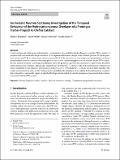Files in this item
An inelastic neutron scattering investigation of the temporal behaviour of the hydrocarbonaceous overlayer of a prototype Fischer-Tropsch to olefins catalyst
Item metadata
| dc.contributor.author | Davidson, A.L. | |
| dc.contributor.author | Webb, Paul B. | |
| dc.contributor.author | Parker, S.F. | |
| dc.contributor.author | Lennon, D. | |
| dc.date.accessioned | 2021-04-09T16:30:03Z | |
| dc.date.available | 2021-04-09T16:30:03Z | |
| dc.date.issued | 2021-03-17 | |
| dc.identifier | 273735162 | |
| dc.identifier | 26e119b0-716c-4b41-a266-e985b092731c | |
| dc.identifier | 85102589128 | |
| dc.identifier | 000629851400001 | |
| dc.identifier.citation | Davidson , A L , Webb , P B , Parker , S F & Lennon , D 2021 , ' An inelastic neutron scattering investigation of the temporal behaviour of the hydrocarbonaceous overlayer of a prototype Fischer-Tropsch to olefins catalyst ' , Topics in Catalysis , vol. First Online . https://doi.org/10.1007/s11244-021-01419-y | en |
| dc.identifier.issn | 1022-5528 | |
| dc.identifier.other | RIS: urn:0588106CA7D69BE1DB8604492CD5877B | |
| dc.identifier.other | ORCID: /0000-0003-2532-344X/work/92020235 | |
| dc.identifier.uri | https://hdl.handle.net/10023/23005 | |
| dc.description | Sasol Ltd., the University of Glasgow and the EPSRC [award reference EP/P505534/1] are thanked for the provision of a postgraduate studentship (ALD). The Royal Society is thanked for the provision of an Industry Fellowship (PBW). | en |
| dc.description.abstract | A dual sodium and sulfur promoted haematite, representative of a candidate Fischer-Tropsch to olefins (FTO) catalyst, is prepared and contrasted with the performance of an unpromoted hematite sample in the ambient pressure CO hydrogenation reaction at 623 K as a function of time-on-stream (0–24 h). In-situ post-reaction temperature-programmed oxidation measurements show the carbon evolutionary phase of the catalyst conditioning process to be retarded for the FTO catalyst. Ex-situ inelastic neutron scattering measurements show the promoters perturb the formation of a previously described hydrocarbonaceous overlayer. Specifically, whilst the sp3 hybridised C–H modes of the hydrocarbonaceous overlayer are almost unaffected by the additives, the formation of the overlayer’s sp2 hybridised C–H modes are noticeably impeded. The results are discussed in terms of the Na/S promoters disturbing the formation of an ordered hydrocarbonaceous overlayer that is thought to constrain the supply of adsorbed hydrogen atoms, which favours the formation of unsaturated hydrocarbons associated with the FTO process. | |
| dc.format.extent | 7 | |
| dc.format.extent | 1162374 | |
| dc.language.iso | eng | |
| dc.relation.ispartof | Topics in Catalysis | en |
| dc.subject | Fischer-Tropsch to olefins catalysis | en |
| dc.subject | Inelastic neuron scattering | en |
| dc.subject | Temperature-programmed oxidation | en |
| dc.subject | QD Chemistry | en |
| dc.subject | NDAS | en |
| dc.subject.lcc | QD | en |
| dc.title | An inelastic neutron scattering investigation of the temporal behaviour of the hydrocarbonaceous overlayer of a prototype Fischer-Tropsch to olefins catalyst | en |
| dc.type | Journal article | en |
| dc.contributor.sponsor | The Royal Society | en |
| dc.contributor.institution | University of St Andrews. School of Chemistry | en |
| dc.identifier.doi | 10.1007/s11244-021-01419-y | |
| dc.description.status | Peer reviewed | en |
| dc.identifier.grantnumber | IF140013 | en |
This item appears in the following Collection(s)
Items in the St Andrews Research Repository are protected by copyright, with all rights reserved, unless otherwise indicated.

